FUNDAMENTAL SHAOLIN KUNGFU TRAINING PROGRAMME OF SHAOLIN WAHNAM
Review of Intensive Shaolin Kungfu Course of October 2006

Roeland of Netherland and James of Scotland in free sparring during the Intensive Shaolin Kungfu Course in October 2006
The Intensive Shaolin Kungfu Course of October 2006 in Malaysia was one of the best ever held. All the participants prepared themselves well before attending the course. Hence they focused on developing skills rather than learning techniques, and all the sixteen basic combat sequences were completed ahead of time, enabling the participants explore other aspects of kungfu training, like familiarizing themselves with techniques, tactics and skills useful for dealing with opponents of other martial systems.
The participants were:
- Roeland Dijkema of Netherland
- Alexander James of England
- Eugene Butterworth of England
- Andy Brough of England
- Maxwell Alderton of England
- James Mousley of Scotland
- Peter Maisden of Scotland
- Padraig Shanahan of Ireland
- Lee Wee Joo of Malaysia
- Lee Hwan King of Malaysia
Also present was Sifu Ronan Sexton of England who provided much help and guidance to the course participants.
The video clips show some of the lessons at the course. They serve as source material for those who wish to review the Shaolin Kungfu training programme in Shaolin Wahnam as well as for those who wish to prepare themselves to attend Intensive Shaolin Kungfu Courses in future.
But please note that although the general aims and instructional material are the same, every intensive course is different because Grandmaster Wong always teaches according to the needs and developmental levels of the participants for their best benefits. Hence, not all the material presented here is necessarily repeated in all intensive courses.
FUNDAMENTAL SHAOLIN KUNGFU TRAINING PROGRAMME OF SHAOLIN WAHNAM
- Stances: the Foundation for Internal Force and Combat Efficiency
- Footwork Secrets for Health, Efficiency and Elegance
- Moving into a Same Direction using Different Ways to Gain Advantages
- Picture-Perfect Forms and Flowing Movements
-
From Random Fighting to Patterns, then to Sequences and Sets
- One-Step Sparring to Develop Combat Skills
- From Pre-Arranged Sparring to Guided Sparring
- Using Techniques and Tactics in Sparring
- The Five Basic Kicks
-
The Secrets of Side Kicks and Continuous Cannons
- How You may Defeat Opponents Experienced in Random Free Sparring
- How Would a Fragile Girl Counter a Powerful Sweeping Kick from a Muay Thai Fighter?
- Shaolin Felling Techniques and their Defences
- Safety First Before Executing Felling Techniques
-
From Combat Sequences to Free Sparring
- Sixteen Combat Sequences and Five Kungfu Sets
- Surprise your Attacker with a Counter-Attack
- Working out Ways to Fight a Boxer
- Effective Tactics and Techniques against Boxers
-
From Gross Outline to Fine Details
- Exploiting Advantage to Clinch Victory
- Variety of Kungfu Techniques against Boxers
- Analysis of Techniques Used against Boxers
- Using Shaolin Kungfu against Boxing in Free Sparring
-
Effective Shaolin Tactics and Techniques against Kick-Boxing
- Shaolin Kungfu against Kick-Boxing in Free Sparring
- How to Handle a Karate Exponent
- How to Handle a Taekwondo Exponent
- How to Handle a Wrestling Exponent
-
Understanding the Typical Attacks of Muay Thai Fighters
- Grandmaster Ho's Secrets in Countering Muay Thai Fighters
- First Avoid Defeat, Then Secure Victory
- Countering the Elbow and Knee Attacks of Muay Thai Fighters
1. Stances: The Foundation for Internal Force and Combat Efficiency
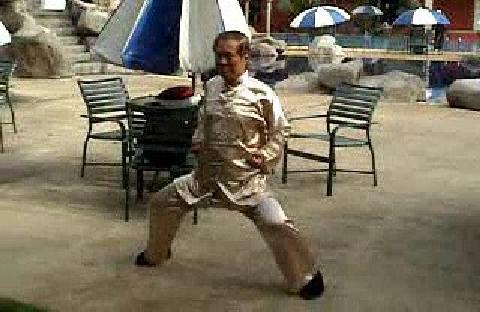
Why is stance training so very important? It is because it forms the foundation of kungfu. Although many people have heard of this statement, not many actually know what this means. Stance training develops internal force, and the use of stances enhance combat efficiency. Ironically, many students and some masters today discard stances for bouncing about.
Click here to enter.
2. Footwork Secrets for Health, Efficiency and Elegance
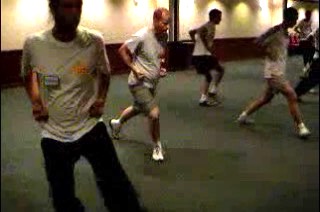
Footwork is an essential aspect in kungfu training, but it is often neglected. As a result, many kungfu practitioners bounce about like Boxers. Worse, due to their ignorance of correct kungfu footwork, many kungfu students and even instructors have sustained long-term knee injuries. In this and the subsequent video series, Grandmaster Wong reveals some important secrets of kungfu footwork. It is the first time in Shaolin Wahnam history that these secrets are explained in public.
Click here to enter.
3. Moving into a Same Direction using Different Ways to Gain Advantages

There are many different ways to move into one particular direction. These different ways can give you certain advantages. Reversely, if you do not understand these principles and move randomly, you may place yourself in disadvantageous positions without your opponents doing anything.
You will have a systematic understanding of the various ways of movement if you analyze the various movements into the following factors: right or left mode, step forward or roll forward or to any direction, yin, yang or central approach, clockwise or anti-clockwise turning, and front-point, mid-point or end-point reference.
Click here to enter.
4. Picture-Perfect Forms and Flowing Movements
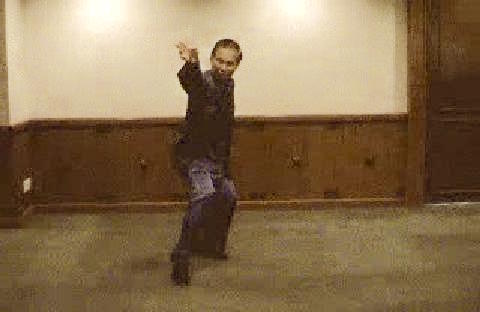
Early fighters fought randomly, not unlike most untrained persons do today. Those who fought regularly and frequently discovered from direct experience that certain ways of fighting, like striking in a particular manner and moving in a particular fashion, gave them various advantages. Over many centuries these particular ways of fighting evolved into formalized patterns. Later, kungfu masters linked various patterns into sequences, and sequences into sets. Such developments over many centuries were possible when fighting was taught as an institutionalized art as in the Shaolin Monastery, not as personal abilities.
Click here to enter.
5. From Random Fighting to Patterns, then to Sequences and Sets

Combat application came before patterns. In other words, it was not true that kungfu masters first thought out the patterns, then found combat application for them. In reality it was the other way round. First there was combat. There were no patterns. Gradually those who fought frequently discovered that by adopting certain postures and moving their hands in certain manners, they could fight more effectively. This took a long time to evolve, but eventually these preferred ways were stylized into patterns.
Click here to enter.
6. One-Step Sparring to Develop Combat Skills
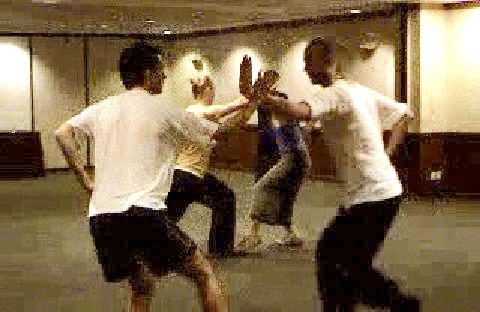
If students only learn forms, they will never know how to apply them in combat no matter how beautifully they perform the forms in solo demonstration. If the training is not systematic, the students are unlikely to be combat efficient. There is so much to be learnt and practiced in kungfu that without systematic training, students will be overwhelmed by the sheer scope and depth of kungfu combat that they will probably resort back to random fighting.
Click here to enter.
7. From Pre-Arranged Sparring to Guided Sparring

Very few kungfu practitioners of any style today can use kungfu patterns for sparring. The situation has become so bad that some masters even think that kungfu cannot be used for fighting! Of course, kungfu can be used for fighting. Records clearly show that kungfu practitioners in the past effectively used kungfu patterns and skills for combat. Some members in our Shaolin Wahnam Family also used kungfu effectively in real fights. We do not glorify fighting, and would rather not fight if given a choice, but we can speak from experience that kungfu is effective for fighting.
Click here to enter.
8. Using Techniques and Tactics in Sparring
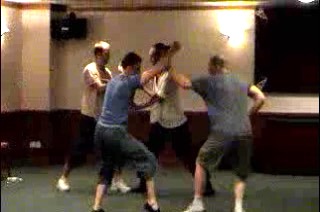
In this video series the focus is on expanding the repertoire of combat techniques. Sparring skills are further developed. At this stage of our sparring methodology, while the movements are not predetermined, they are also not totally free. Control is gradually released, and course participants are given appropriate guidelines so they can effectively apply kungfu skills, techniques and tactics in attack and defence spontaneously.
Click here to enter.
9. The Five Basic Kicks
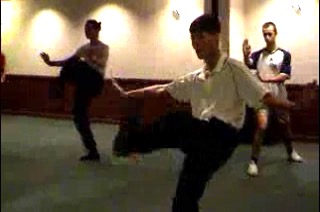
Many people, even some masters, mistakenly think that there are very few or no kicks in kungfu. Actually there are more kicks in Shaolin Kungfu than all the kicks of all other martial arts put together! This is not an exaggeration. Shaolin Kungfu is noted for “thirty six kicking techniques”, and there may be more than one kick in each kicking technique.
Click here to enter.
10. The Secrets of Side Kicks and Continuous Cannons

There is a kungfu saying that the hands are meant for opening an opponent, the legs are meant to defeat him. A manifestation of this saying is found in kicks. Kungfu kicks are purposely inconspicuous; they connect without an opponent realizing them. Those interested in kungfu stories may have heard of the historic thirteen Shaolin monks helping Li Shih Min establish the Tang Dynasty. At an imperial celebration, the leader of the monks, Yuan Zhong, who declined to be made the grand-general, gave a demonstration of Shaolin Kungfu. He demonstrated a Shaolin set called “Bao Quan”, which means “Cannon Fist”. Some of the video clips below show the secret of the Cannon Fist.
Click here to enter.
11. How You may Defeat Opponents Experienced in Random Free Sparring

Grandmaster Wong advised Douglas to use his combat sequences. “Just use any of the combat sequences you have learnt from me.” Douglas frankly answered, “I haven't practiced them. I can't remember any!” As the kungfu master was already panting heavily for breath, Grandmaster Wong told them to have a break. He took Douglas out and showed him Combat Sequence 10. Douglas went over the sequence a few times. When they resumed free sparring a few minutes later, without a single exception every time Douglas applied the sequence he pressed the kungfu master to a wall.
Click here to enter.
12. How Would a Fragile Girl Counter a Powerful Sweeping Kick from a Muay Thai Fighter?
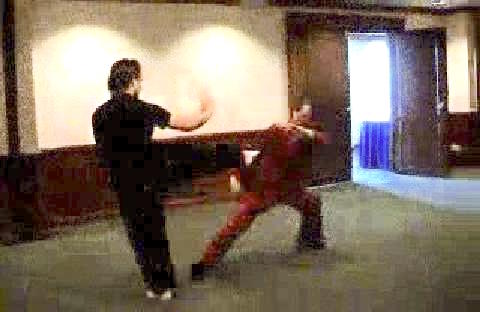
Once Grandmaster Ho Fatt Nam asked Grandmaster Wong, “How would a fragile female kungfu practitioner block a powerful sweeping kick from a Muay Thai fighter?” Grandmaster Ho continued, “There is no need to block. Blocking would fracture the poor girl's arms.” This video series concerns whirlwind kicks, which are similar to sweeping kicks of Muay Thai fighters. The standard counter against whirlwind kicks is an intercepting technique using the pattern “Bar the Big Boss”. A “softer” counter is “Tame Tiger with String of Beads”, a beautiful pattern that can also be used against any kicks!
Click here to enter.
13. Shaolin Felling Techniques and their Defences

Many people have the mis-conception that there are no throws in Shaolin Kungfu. Actually there are more throws in Shaolin Kungfu than in martial arts known for throws like Judo. Throwing is only one of the techniques in the category of techniques called felling with the objective of felling an opponent onto the ground. In Shaolin Kungfu there are many other ways of felling an opponent besides throwing, and some of these do not need holding an opponent first before felling him. These various felling techniques are traditionally known in Shaolin Kungfu as “Siew Lam Sap Pat Thiet” (“Shao Lin Si Ba Tet”), or the “Shaolin Eighteen Felling Techniques”.
Click here to enter.
14. Safety First Before Executing Felling Techniques

Although felling techniques are generally not combat-ending, some are because they can cause severe or fatal injury. One example of a combat-ending felling technique is “Farmer Hoes Rice Field”, which is shown in this video series. It is essential to ensure your own safety when felling an opponent. If you leave your opponent's hands free when throwing him, for example, he may gorge your eyes or tear off your throat. We would not use such drastic moves on our opponents, but we must never presume that they may not use them on us.
Click here to enter.
15. From Combat Sequences to Free Sparring

Students may be able to use kungfu patterns in pre-arranged combat sequence training, but can they still use kungfu patterns effectively and spontaneously in free sparring? Yes, they can if they are systematically trained. The video series here show course participants of the Intensive Shaolin Kungfu Course of October 2006 progress from using kungfu patterns in combat sequences to using kungfu patterns in free sparring. First, there is full control. The control is gradually and systematically released until eventually they are sparring freely.
Click here to enter.
16. Sixteen Combat Sequences and Five Kungfu Sets

Combat sequences constitute an essential aspect of our sparring methodology. First you employ them for pre-arranged sparring. Then the control is gradually and systematically released through various stages until eventually you free spar using Shaolin techniques and skills. Kungfu sets are formed from patterns and sequences. There are many objectives in practicing kungfu sets. By practicing a set you go over all the important techniques as well as skills that set is designed for.
Click here to enter.
17. Surprise your Attacker with a Counter-Attack

As you move in to attack, you must be ready for a sudden counter-attack from your opponent. You need to neutralize these surprised counters and continue your intended attacks. Three types of surprised counters are dealt with, namely striking, kicking and gripping. On the other hand, using a surprised counter as an opponent rushes in to attack is an effective way to defeat him, especially if you follow up with continued attacks. Good judgment, right time and right spacing are important in executing surprised counters. But surprised counters should be used as a surprise, and not every time your opponent attacks.
Click here to enter.
18. Working out Ways to Fight a Boxer
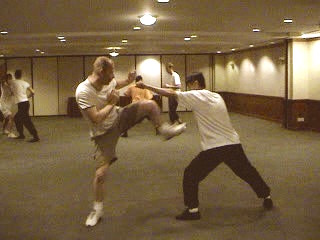
If you wish to be combat efficient, you have to learn and practice how to fight a Boxer. Why is fighting a Boxer so important? The strong points of a Boxer are his speed and agility. His weaknesses are his techniques are limited and his attack and defence are relatively in short range. How would you avoid his strong points and exploit his weaknesses? The video clips in this series show participants at the Intensive Shaolin Kungfu Course of October 2007 in Malaysia working out amongst themselves some effective ways to fight Boxers. Would you be able to work out some effective ways yourself by watching these videos?
Click here to enter.
19. Effective Tactics and Techniques against Boxers

What tactics and techniques you would use against Boxers? The video series here show the participants demonstrate and consolidate tactics and techniques they have found useful from their own experience. Tactics refer to application of general principles, like using “long against short” and using stances and body-movements to compensate for speed. Techniques refer to using specific kungfu patterns to implement these tactics, like using “Fierce Tiger Speeds Through Valley” to effect a long strike compared to a Boxer's short jabs, and sinking a Bow-Arrow Stance backward without moving the feet to avoid the speedy attacks of a Boxer.
Click here to enter.
20. From Gross Outline to Fine Details

Why are most kungfu practitioners today unable to fight a Boxer? It is certainly not because kungfu techniques and skills are inferior. The straight-forward answer is that most kungfu practitioners today have never been trained to fight. We in Shaolin Wahnam believe that we can, and should, use kungfu skills and techniques for fighting, and we are ready to disclose how we do so with other kungfu practitioners who share the same philosophy. This series is part of a few series depicting how we use Shaolin tactics and techniques against Boxers.
Click here to enter.
21. Exploiting Advantage to Clinch Victory

In combat, when an opportunity arises you exploit it not just to hit your opponent once and then start all over again, but use it to initiate a series of concerted attacks to defeat your opponent. In kungfu terminology, this is known as “tak sai bat yiew jen” (Cantonese pronunciation). Literally it means “gaining advantageous situation, you do not let your opponent escape”, but figuratively it means that when an opportunity arises you exploit it to clinch victory.
Click here to enter.
22. Variety of Kungfu Techniques against Boxers

Besides the techniques worked out by the course participants themselves for use against Boxers, there are many other effective ones. Some of these are demonstrated by Grandmaster Wong and Sifu Ronan in this video series, and they include all the four categories of striking, kicking, felling and gripping. All the movements here are impromptu and not pre-arranged. Hence, if any kungfu practitioner cannot spar against a Boxer, it is not due to a lack of effective kungfu techniques. It is probably due to his lack of a systematic sparring methodology. If he wishes to remedy this situation, he can get a lot of ideas and material from the few video series here.
Click here to enter.
23. Analysis of Techniques Used against Boxers

This series discloses an important aspect of kungfu training not normally found in most other kungfu schools, namely technique analysis. With advice and help from Grandmaster Wong, course participants give reasons for the choice of their techniques and tactics, followed by comments from fellow participants. As a bonus, the video clips here also give an idea to kungfu practitioners not familiar with kungfu combat application, how kungfu patterns can be used for combat. Many kungfu forms may appear merely decorative, but their functional beauty comes alive when matched with an opponent's movements.
Click here to enter.
24. Using Shaolin Kunfu against Boxing in Free Sparring
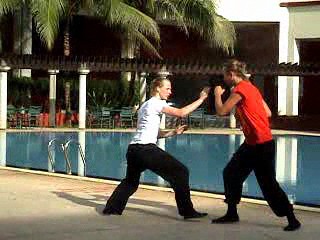
Some uninitiated observers may criticize the participants here for their lack of aggression or brutality. Being used to hurting one another in free sparring, they may wonder whether the sparring depicted here is effective. Instead of being annoyed, we should feel complimented. Being aggressive or brutal has never been our objective. Indeed, their criticism confirms for us that we are able to attain what internal masters in the past did, i.e. an internal martial artist can be gentle and elegant, yet powerful and effective — in combat as well as in daily life.
Click here to enter.
25. Effective Shaolin Tactics and Techniques against Kick-Boxing

The tactics and techniques against a Boxer can be used against a Kick-Boxer too, except that we need to take care of their kicks. Nevertheless, if we wish to be more combat effective, handling a Kick-Boxer requires special treatment because the way a Kick-Boxer fights is quite different from that of a Boxer. A Kick-Boxer is more like a Muay-Thai fighter, though he is usually less aggressive and also less tricky, and uses elbow and knee techniques less frequently.
Click here to enter.
26. Shaolin Kungfu against Kick-Boxing in Free Sparring

After learning some effective Shaolin tactics and techniques against Kick-Boxing, the course participants apply them in free sparring against sparring partners who act as Kick-Boxers. This is only logical. We apply what we practice. Yet, surprisingly it may be, many kungfu practitioners today don't do this. They practice kungfu, but when it comes to free sparring or real fighting, they discard what they have learnt and practiced and use Kick-Boxing, or whatever style their opponents are using. You must guard against such mistakes.
Click here to enter.
27. How to Handle a Karate Exponent

From the perspective of tactics and techniques, handling a Karate exponent is comparatively easy -- easier than handling a Boxer or a Kick-Boxer, for example. This statement should not be taken as an insult to Karate, or belittling it, though unfortunately it is often the case. This is our dilemma of being truthful. But we must realize that the above statement does not mean a Karate exponent is not formidable, nor a kungfu exponent will necessary beat a Karate exponent.
Click here to enter.
28. How to Handle a Taekwondo Exponent

Fighting against Taekwondo exponents is comparatively easy — if you know the appropriate tactics and techniques and have the relevant skills. Again, this does not mean that Taekwondo exponents are not formidable, or that a kungfu exponent will necessarily beat a Taekwondo opponent. Grandmaster Wong shared with the course participants many of the tactics and techniques he found effective against Taekwondo. A very important point Grandmaster Wong advises is that you must go into, and not retreat from, a Taekwondo exponent.
Click here to enter.
29. How to Handle a Wrestling Exponent

What many people may not realize is that Wrestling is a sport, and not a fighting art. This does not mean that a Wrestler is not a formidable fighter. But one must remember that, especially if you are an amateur, using Wrestling for real fighting without any safety rules can be very dangerous. Some basic Shaolin techniques against Wrestling practiced by the course participants of the Intensive Shaolin Kungfu Course of October 2006 are shown in the video clips below.
Click here to enter.
30. Understanding the Typical Attacks of Muay Thai Fighters

Grandmaster Wong's sifu, Grandmaster Ho Fatt Nam who was a Muay Thai champion himself, believed that apart from Shaolin masters, Muay Thai fighters were the most formidable opponents. Muay Thai fighters were not only fast and powerful but also very tricky. We in Shaolin Wahnam are very lucky because Grandmaster Ho taught Grandmaster Wong many secrets in fighting against a Muay Thai fighter, and Grandmaster Wong shares some of these secrets in the video clips here. Firstly, we must understand the opponent before we plan how to beat him. Sifu Ronan, who has spent many years practicing Muay Thai, demonstrates some typical Muay Thai attacks.
Click here to enter.
31. Grandmaster Ho's Secrets in Countering Muay Thai Fighters
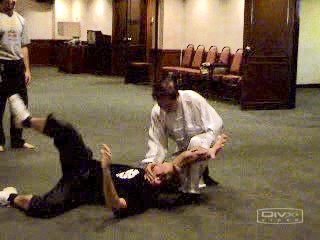
Muay Thai was at its height at the time when Grandmaster Wong was learning from Grandmaster Ho. Muay Thai fighters were winning matches in the rings against martial artists of other styles. The Muay Thai knee jabs, where a Muay Thai fighter would put his hands around the neck of his opponent and throw continuous knee jabs, were dreaded by many martial artists. Fortunately for us, Grandmaster Wong learned many secrets from Grandmaster Ho on how to handle Muay Thai fighters. Grandmaster Wong shares many of these secrets here, including how to counter the dreaded knee jabs.
Click here to enter.
32. First Avoid Defeat, Then Secure Victory

Muay Thai fighters are fast, powerful and agile. Muay Thai fighters employ feint moves frequently. When an opponent fails to defend against a feint move, it becomes real. On the other hand, when an opponent attempts to defend a real move, it becomes feint, In kungfu terminology this is known as “huai huai shat shat”, or “false false real real”. This false-real tactic employed in continuous attacks makes a Muay Thai fighter a formidable opponent.
To avoid being defeated, you need to take note that Muay Thai attacks seldom come singly; they usually come in a series known as “three-three-nine”, and Muay Thai fighters frequently use the false-real tactic. Having ensured that you won't be defeated, the next step is to clinch victory. A good strategy is to fell him onto the ground first so that he could not use his elbow and knee attacks, then execute your coup de grace or decisive strike. The video series here provide many examples.Click here to enter.
33. Countering the Elbow and Knee Attacks of Muay Thai Fighters
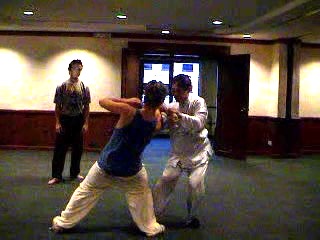
Muay Thai fighters use elbow and knee attacks frequently. Blocking such attacks, which is a common defence of many martial artists, is not advisable. These attacks are very powerful and in short range. It needs a powerful block executed quickly to stop them. More formidably, as soon as you block one attack, another attack arrives, followed by more attacks in quick succession. Some effective counters are to lock their elbows, lock their kicking legs, and fell them onto the ground. You will find some examples in the video series here. You will also learn how to counter if a Muay Thai fighter grabs your head with one hand, and elbows your head at close range with the other.
Click here to enter.
LINKS
- Stances: the Foundation for Internal Force and Combat Efficiency
- Footwork Secrets for Health, Efficiency and Elegance
- Moving into a Same Direction using Different Ways to Gain Advantages
- Picture-Perfect Forms and Flowing Movements
-
From Random Fighting to Patterns, then to Sequences and Sets
- One-Step Sparring to Develop Combat Skills
- From Pre-Arranged Sparring to Guided Sparring
- Using Techniques and Tactics in Sparring
- The Five Basic Kicks
-
The Secrets of Side Kicks and Continuous Cannons
- How You may Defeat Opponents Experienced in Random Free Sparring
- How Would a Fragile Girl Counter a Powerful Sweeping Kick from a Muay Thai Fighter?
- Shaolin Felling Techniques and their Defences
- Safety First Before Executing Felling Techniques
-
From Combat Sequences to Free Sparring
- Sixteen Combat Sequences and Five Kungfu Sets
- Surprise your Attacker with a Counter-Attack
- Working out Ways to Fight a Boxer
- Effective Tactics and Techniques against Boxers
-
From Gross Outline to Fine Details
- Exploiting Advantage to Clinch Victory
- Variety of Kungfu Techniques against Boxers
- Analysis of Techniques Used against Boxers
- Using Shaolin Kunfu against Boxing in Free Sparring
-
Effective Shaolin Tactics and Techniques against Kick-Boxing
- Shaolin Kungfu against Kick-Boxing in Free Sparring
- How to Handle a Karate Exponent
- How to Handle a Taekwondo Exponent
- How to Handle a Wrestling Exponent
-
Understanding the Typical Attacks of Muay Thai Fighters
- Grandmaster Ho's Secrets in Countering Muay Thai Fighters
- First Avoid Defeat, Then Secure Victory
- Counteroing the Elbow and Knee Attacks of Muay Thai Fighters
